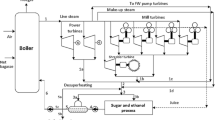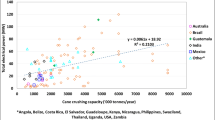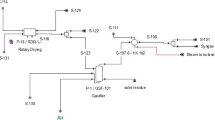Abstract
It is known that there is a significant amount of thermal energy used for the sugar cane industry for the purpose of power production and for use in the sugar or ethanol processing in cane sugar industries. Likewise, it is understood that there are substantial amounts of waste heat that is not being recovered, in particular for traditional sugar mills. Regardless of this, energy conservation is given less consideration as compared to operational convenience due to the fact that sugar mills are self-sufficient in energy (heat and power). The identification of such potential heat loss areas (especially during transient conditions) suggests the sugar mills play a vital role in energy saving. In this study, a modified setup of the base case plant considered in part I of this paper is assessed for its energy potential and possible major heat losses during steady state and transient conditions where 2-h stoppage of the mill presses are considered to occur. For the modified setup, there are two major scenarios considered having two sub-scenarios each. The result of the assessment showed that the steady state assumption scenario of the modified plant (where bagasse drying is not considered) indicated a 20 % reduction in the losses considered which resulted in a 57 % power generation increase as compared to the steady state model of the base case plant. It is also possible to save excess bagasse by drying the bagasse for later use during unexpected stoppage. The carbon dioxide emission (amounting 29 t/day in case 2a of this study) that occurs during the use of fuel oil during such stoppages will thus be avoided. The simple economic analysis showed that it is only in case 2a where fuel oil cost is included in the operation cost that resulted in a negative NPV. Since the rest of the scenarios use bagasse as a fuel which is free, the NPV for all was positive. For the electricity price of 0.04 US $/kWh and discount rate of 15 %, the minimum payback period attained is about 3 years (case 1b) where the bagasse moisture content is 30 % whereas the maximum payback period is 6 years (case 1a) where there is no bagasse drying considered.



Similar content being viewed by others
Notes
According to ZURN’s design document [21], these losses are Lash = 3.5, Lrad = 0.41 and LMM = 1.5 %
Abbreviations
- EEPCo:
-
Ethiopian Electric Power Corporation
- FSF:
-
Finchaa Sugar Factory
- FW:
-
Feed water
- NPV:
-
Net present value
- PBP:
-
Payback period
- TCD:
-
Tonnes of cane per day
- C:
-
Carbon content [%]
- CP :
-
Specific heat capacity [kJ/kg-°C]
- E:
-
Emission (accumulated per day) [tonnes]
- \( \overset{\cdot }{\mathrm{E}} \) :
-
Emission [tonnes/day]
- F:
-
Moisture content [wt%]
- h:
-
Enthalpy [kJ/kg]
- H:
-
Hydrogen content [%]
- HHV:
-
Higher heating value [kJ/kg]
- i:
-
Interest rate [%]
- Inv:
-
Investment [USD]
- L:
-
Loss [%]
- LHV:
-
Lower heating value [kJ/kg]
- m:
-
Mass kg or tonnes
- \( \overset{\cdot }{\mathrm{m}} \) :
-
Mass flow [kg/s] or [tonnes/day]
- O:
-
Oxygen content [%]
- P:
-
Pressure [bar]
- PLoss:
-
Loss [kW], [MW] or [GJ/day]
- R:
-
Revenue [USD/year]
- Q:
-
Heat demand (accumulated per day) [GJ/day]
- \( \overset{\cdot }{\mathrm{Q}} \) :
-
Heat flow [kW] or [GJ/day]
- S:
-
Sulphur [%]
- T:
-
Temperature [°C]
- W:
-
Work output (accumulated per day) [GJ/day]
- \( \overset{\cdot }{\mathrm{W}} \) :
-
Power output [kW]
- x:
-
Steam quality
- Ĉ:
-
Cost [USD]
- Ƞ:
-
Efficiency [%]
- α:
-
Electricity sales price [USD/kWh]
- ρ:
-
Density [kg/L]
- r:
-
Heat of vaporization of water [kJ/kg]
- μ:
-
Mass ratio [kg/kg]
- A:
-
Air
- Acc:
-
Accumulated
- Act:
-
Actual
- B:
-
Boiler
- BC:
-
Base case
- D:
-
Dry
- Eqp:
-
Equipment
- El:
-
Electrical
- Eng:
-
Engineering
- Ex:
-
Excess
- F:
-
Fuel
- Fg:
-
Flue gas
- G:
-
Generator
- Is:
-
Isentropic
- Ins:
-
Installed
- Lat:
-
Latent
- MA:
-
Moisture in air
- Me:
-
Mechanical
- MM:
-
Manufacturer’s margin
- n:
-
Normal conditions (0 °C and 1.013 bar)
- New:
-
New moisture content
- OP&M:
-
Operation and maintenance
- PT:
-
Power turbine
- pur:
-
Purchase
- Rad:
-
Radiation
- sm:
-
Shredder and mill
- st:
-
Steam
- tr:
-
Transmission
- tot:
-
Total
- w:
-
Water
- Sen:
-
Sensible
References
Olivério LJ, Ferreira MF (2010) Cogeneration—a new source of income for sugar and ethanol mills or bioelectricity a new business. Proc Int Soc Sugar Cane Technol 7
Hugot E (1986) Handbook of sugar cane engineering, 3rd edn. Elsevier, New York
Deshmukh R, Jacobson A, Chamberlin C, Kammen C (2013) Thermal gasification or direct combustion? Comparison of advanced cogeneration systems in the sugarcane industry. Biomass Bioenergy 55:163–164
Brazilian Sugarcane Industry Association (UNICA) (2013) http://sugarcane.org/resource-library/books/Folder%20and%20Brochure.pdf. Accessed Feb 2014
ISO (International Sugar Organization) (2009) Cogeneration-opportunities in the world sugar industry. http://www.isosugar.org. Accessed Jan 2014
WADE, World Alliance for Decentralized Energy (2004) Bagasse cogeneration global review and potential. https://cdm.unfccc.int/filestorage/2/K/J/2KJXDVUHFZ0MYG3WOBT91NA7QE6LP5/4057Annex6BagasseCogeneration-GlobalReviewandPotential.pdf?t=M098bm9qdTNxfDBDkAsZVdlUBjCPmWdKPybd. Accessed Jan 2014
Pellegrini FL, Oliveira SO Jr (2011) Combined production of sugar, ethanol and electricity: thermoeconomic and environmental analysis and optimization. Energy 36:3704–3715
Premalatha M, Priya SS, Sivaramakrishnan V (2008) Efficient cogeneration scheme for sugar industry. J Sci Ind Res 67:239–242
Johansson TB, Kelly H, Reddy A, Williams R (eds) (1993) Renewable energy—sources for fuels and electricity Island Press, chapter on “Advanced gasification-based biomass power generation, references 45 and 46”
Sedl Jay Mahesh sugar mill—case study. Available at: http://issuu.com/firetreedesign/docs/sgm_brevini_mill_drives_-case_study_sedl_jay_mahe. Accessed Mar 2014
ABB (2010) ACS 1000 variable speed drives increase energy efficiency at sugar plant-case study. http://www05.abb.com/global/scot/scot216.nsf/veritydisplay/46ae6cf38fa1228bc12577e40056e21d/$file/CS_Sugar%20RevB_lowres.pdf. Accessed Feb 2014
Ensinas VA, Lozano MA, Serra LM (2007) Analysis of process steam demand reduction and electricity generation in sugar and ethanol production from sugarcane. Energy Convers Manag 48:2978–2987
Finchaa Sugar Factory (FSF) (2012) Interview and documents gathered during field study
Yarnal SG, Vinod S, Puranik SV (2010) Energy management study in sugar industries by various bagasse drying methods. Strateg Plan Energy Environ 29(3):56–78. doi:10.1080/10485231009595087
Birru (2007) Investigation of the potential of cane sugar industries. Msc thesis, Royal Institute of Technology-KTH, Sweden
Modesto MJ, Zemp JR, Nebra AS (2009) Ethanol production from sugar cane: assessing the possibilities of improving energy efficiency through exergetic cost analysis. Heat Trans Eng 30(4):272–281. doi:10.1080/0145763080238038
Alemu A (2009) Energy assessment, energy utilization & generation efficiency—a case study in Finchaa sugar factory. Msc thesis, Royal Institute of Technology-KTH, Sweden
Mujeebu AM, Abdullah ZM, Ashok S (2011) Husk-fueled steam turbine cogeneration for a rice mill with power export—a case study. Energy Sources Part A Recover Utilization Environ Eff 33(8):724–734. doi:10.1080/15567030903226298
ECN (2012) Database for biomass and waste. https://www.ecn.nl/phyllis2/. Accessed Jan 2015
Energy efficiency guide for industry in Asia (2006) http://www.energyefficiencyasia.org/energyequipment/assessment_boiler_indirectmethod.html. Accessed Aug 2014
ZURN (2006) Boiler design document-USA
Alibaba (2014) Cost of motor+gearbox (2014) Available at: http://www.alibaba.com/trade/search?fsb=y&IndexArea=product_en&CatId=&SearchText=motor+mounted+gearbox+sugar. Accessed May 2014
ABB Sverig team (2014) Svensk Försäljning Motorer, Drivsystem & Kraftkonvertering / Domestic sales motors, drives and power conversion
SENTECH Incorporated Commercial and Industrial CHP Technology Cost and Performance Data Analysis for EIA (2010) http://www.meede.org/wp-content/uploads/Commercial-and-Industrial-CHP-Technology-Cost-and-Performance-Data-Analysis-for-EIA_June-2010.pdf. Accessed Jan 2015
Alibaba (2014) Cost of bagasse dryers (2014). http://www.alibaba.com/product-detail/High-Quality-China-bagasse-rotary-dryer_1309967662.html?s=p. Accessed May 2014
Finance formulas (2014) http://financeformulas.net/Net_Present_Value.html. Accessed Sept 2014
EEPCo-Ethiopian Electric Power Corporation (2012) http://www.eepco.gov.et/. Accessed Jan 2014
Finance formulas (2014) http://www.financeformulas.net/Payback_Period.html. Accessed Sept 2014
Cardozo E, Erlich C, Alejo L, Fransson TH (2014) Combustion of agricultural residues: an experimental study for small-scale applications. Fuel 115:778–787
Acknowledgments
Many thanks for the financial support of the Swedish International Development Cooperation Agency (SIDA) that fully funds this project. Thanks to all from Finchaa Sugar Factory, Ethiopian Sugar Corporation, and Ethiopian Electric Power Corporation personnel who helped in gathering relevant data during field study.
Author information
Authors and Affiliations
Corresponding author
Rights and permissions
About this article
Cite this article
Birru, E., Erlich, C., Beyene, G.B. et al. Upgrading of a traditional sugar cane mill to a modern mill and assessing the potential of energy saving during steady state and transient conditions—part II: models for a modified cogeneration unit. Biomass Conv. Bioref. 6, 233–245 (2016). https://doi.org/10.1007/s13399-015-0180-8
Received:
Revised:
Accepted:
Published:
Issue Date:
DOI: https://doi.org/10.1007/s13399-015-0180-8




